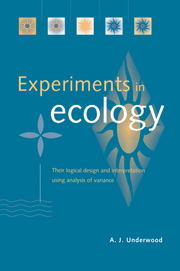Book contents
- Frontmatter
- Contents
- Acknowledgements
- 1 Introduction
- 2 A framework for investigating biological patterns and processes
- 3 Populations, frequency distributions and samples
- 4 Statistical tests of null hypotheses
- 5 Statistical tests on samples
- 6 Simple experiments comparing the means of two populations
- 7 Analysis of variance
- 8 More analysis of variance
- 9 Nested analyses of variance
- 10 Factorial experiments
- 11 Construction of any analysis from general principles
- 12 Some common and some particular experimental designs
- 13 Analyses involving relationships among variables
- 14 Conclusions: where to from here?
- References
- Author index
- Subject index
9 - Nested analyses of variance
Published online by Cambridge University Press: 05 June 2012
- Frontmatter
- Contents
- Acknowledgements
- 1 Introduction
- 2 A framework for investigating biological patterns and processes
- 3 Populations, frequency distributions and samples
- 4 Statistical tests of null hypotheses
- 5 Statistical tests on samples
- 6 Simple experiments comparing the means of two populations
- 7 Analysis of variance
- 8 More analysis of variance
- 9 Nested analyses of variance
- 10 Factorial experiments
- 11 Construction of any analysis from general principles
- 12 Some common and some particular experimental designs
- 13 Analyses involving relationships among variables
- 14 Conclusions: where to from here?
- References
- Author index
- Subject index
Summary
Introduction and need
As made abundantly clear earlier, replication of experimental and sampling units is mandatory to maintain any logical basis for making inferences from experiments. Without replication, there is no way to demonstrate that statistically significant differences among experimental treatments are due to the applied experimental treatments and not simply due to chance variation among the units measured. Replication provides the material from which statistical estimates can be made to provide measures of the intrinsic variation among units.
To obtain replication it is necessary that the appropriate choice and scale of experimental units are used. Underwood (1981) and Hurlbert (1984) found a distressingly large proportion of published studies had no or the wrong replicates, even though inferences were made from quantitative data and statistical tests.
One of the major uses of nested or hierarchical designs of experiments is to ensure appropriate replication. A simple example will illustrate the point. Suppose plants in open fields have been observed to vary in their production of fruit. A model to explain this has, so far, successfully withstood various experimental tests of its predictions. It is that some areas are visited by more insect pollinators and therefore the plants are more fertile. Such a pattern is illustrated in Figure 9.6, below. From this, the hypothesis is proposed that preventing insects from visiting plants in experimental plots will reduce the reproductive success of plants in those plots.
Information
- Type
- Chapter
- Information
- Experiments in EcologyTheir Logical Design and Interpretation Using Analysis of Variance, pp. 243 - 295Publisher: Cambridge University PressPrint publication year: 1996
Accessibility standard: Unknown
Why this information is here
This section outlines the accessibility features of this content - including support for screen readers, full keyboard navigation and high-contrast display options. This may not be relevant for you.Accessibility Information
- 1
- Cited by
